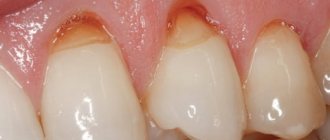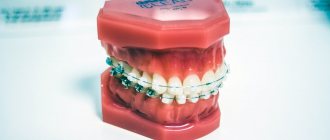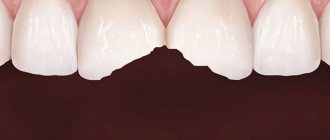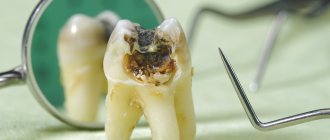Methods of tooth restoration in modern dentistry
Dental restoration methods in modern dental clinics make it possible to completely recreate the shape, color, shine, transparency and light refraction of dental tissue.
I would like to proudly note that teeth restored at the Interdent dental clinic are considered healthy even by dentists from other clinics. What teeth are subject to restoration and what methods of restoration exist? To begin with, it should be noted that teeth that are subject to restoration often require endodontic treatment. Removing inflamed dead pulp residues from the canals, then making a high-quality filling. Without professional root canal treatment, there is no point in proceeding with the actual restoration. The remains of dead tissue, “immured” in the roots or under the roots, will sooner or later make themselves felt by pain or swelling of the gums. Very rarely, a tooth is destroyed in such a way that it needs to be restored with living pulp. In such cases, after a thorough diagnosis, the doctor restores the tooth, keeping it alive. The restoration itself can be single-stage or multi-stage.
When should a tooth be restored?
Teeth are destroyed for many reasons, but the main enemy of teeth is caries, which affects teeth at any age. Most often, caries affects the teeth of those with a sweet tooth, since sweet carbohydrates are a favorable environment for the proliferation of pathogenic bacteria. Over time, bacteria penetrate into the deep tissues of the tooth and form carious cavities in them. Treatment of caries consists of clearing these cavities of dead tissue and filling the tooth. When tooth decay has reached such proportions that it can no longer be restored, the tooth is removed.
One-step restoration
One-stage restoration is a therapeutic procedure, while multi-stage restoration is the restoration of a tooth using an orthopedic method (inlays and veneers). A tooth in need of restoration is significantly damaged, and often, in order to restore the shape of the tooth therapeutically, it is first necessary to install a pin in the root. Pins are available in metal and fiberglass. The latter have little flexibility, which completely prevents root fracture during installation. And they come in white and transparent, which eliminates the influence of their color on the final color of the filling.
Fiberglass posts are more expensive than metal ones, but they are preferable for anterior teeth where esthetics are important. Next, the filling mass is applied layer by layer to the installed pin, like a frame. And this is where the real art begins.
The doctor is not limited in time, because The filling will not harden until it is exposed to the light beam of a gel lamp. But the amount of each layer of material, the sequence of application of different shades, the actual choice of color, and ultimately the modeling depend solely on the professionalism of the dentist. Next, the filling is ground and polished, giving it a final sparkling shine.
In what cases does restoration not make sense?
Many of our patients ask this question. We always answer objectively when it is really worth investing not in restoring your own tooth, but in installing an implant. Of course, there is no clear solution, because each clinical case is individual, but there are many situations where we know for sure that installing an implant will be a much better solution for the patient, both for clinical and financial reasons.
- If the front tooth has already undergone endodontic treatment several times (especially if the treatment was carried out under a microscope), and there are still inflammatory changes in the area of the root apexes, there is no point in treating the root canal again, but it is better to remove the tooth and insert an implant.
- A similar situation occurs when we have a severely damaged coronal part of the tooth due to a subgingival fracture of the tooth, or when a carious cavity reaches the root of the tooth and prosthetic reconstruction using a coronal inlay and a prosthetic crown is very doubtful. In such a situation, it is also better to consider the option of implantation.
Restoration with veneers
A veneer is a ceramic or composite “facet” that is attached to the front (front) surface of the tooth with special light-curing cement. Veneers are used to restore mainly the front group of teeth, the color and shape of which are of particular importance. In order to restore a tooth with a veneer, only the front and slightly cutting surfaces of the tooth are ground down within the enamel layer by only 0.5 mm. Naturally, for this purpose the tooth does not need to be depulped (removing the nerve), unless there are other indications.
Then impressions are taken of the ground tooth or group of teeth, the color is determined, and a ceramic or composite “onlay” is made in the laboratory.
Veneer, unlike filling material, does not change color over time and does not lose its shine. Moreover, a veneer, unlike a one-step tooth restoration, has a clearer marginal fit to the gingival tissue, which is important for the prevention of periodontal diseases.
Most Frequently Asked Questions
Is missing a tooth just unsightly or harmful to health?
Violation of the integrity of the dentition has many negative consequences for health.
- Due to lack of load, periodontal tissue and bone quickly atrophy. The risk of other pathological processes occurring in them increases.
- Violation of chewing function entails a number of gastrointestinal diseases. Vitamins, microelements and other beneficial nutrients are poorly absorbed. This weakens the immune system and triggers the aging mechanisms of the body.
- The teeth shift, do not close completely, and an incorrect bite is formed. As a result, the functioning of the temporomandibular joint is disrupted. A person is bothered by headaches, poor sleep, and strange “clicks” in the head and neck.
- A person is embarrassed to smile, talk, communicate with other people. As a result, he withdraws into himself, leads a solitary life, and develops depression.
I urgently need to restore a lost tooth in 1 session - what method do you recommend?
Installing a temporary immediate denture (they are often called “butterflies” due to their unique shape) allows you to restore the dentition in an extremely short time. The prosthesis is made from individual impressions directly in the dentist’s office and is immediately fixed using special fasteners.
- It looks very natural and is completely indistinguishable from real teeth.
- Does not require preliminary grinding of adjacent teeth.
- Prevents tooth displacement and bone atrophy.
- Provides chewing function.
- Comfortable to wear and does not injure gums.
- Has a low cost.
- It will serve you for several months and protect the ground tooth while a permanent prosthesis is being made or the implant is being healed.
What material makes teeth look most natural?
At the moment, zirconium dioxide is considered the most aesthetic material. Only a professional can distinguish crowns and bridges made from it from natural teeth. The material has good biocompatibility, high strength and even some antibacterial effect. Thanks to the translucency characteristic of real tooth enamel, zirconium dioxide dentures look exactly like natural teeth.
Restoration with tabs
Inlays are also made in the laboratory and come in ceramic and composite. The teeth for inlays are processed in the same way as for filling materials, i.e. all carious dentin is removed, a cavity is formed, and then impressions are taken from it and sent to the laboratory. The finished inlay is attached to the tooth in the same way as a veneer. The advantage of inlays over filling material is that inlays do not undergo polymerization shrinkage, i.e. do not shrink in volume like filling material under the influence of a light beam from a gel lamp. Further, when restoring with inlays teeth that are destroyed in the area of the contact surface with another tooth, almost one hundred percent restoration of the contact point is ensured, which is very important for interdental hygiene.
Veneers and inlays are not polished, since they are provided with shine already in the laboratory. Teeth restored simultaneously with composite filling materials must be polished every 6 months due to the fact that the surface layer of the light-curing composite, the structure of which differs from the structure of the enamel, wears out, becomes rough and retains microparticles of food debris and microbes.
Of course, it is up to the specialist to decide whether to restore using filling material or an orthopedic method, but there are situations when the doctor can offer both options for restoring a tooth, justifying all the pros and cons. Naturally, restoration with veneers and inlays is more expensive, but having paid once for quality treatment, you will not have to periodically return to the doctor with the same problem.
How to restore front teeth
It is important to understand what specific problem we are talking about here.
- If a tooth falls out or is removed, implantation is the best option to restore it.
- If only the coronal part is broken, you can consider the option of replacing the front tooth with a crown (with preliminary installation of a reinforcing tab in the root canal).
- If we are talking about chips, cracks, severe destruction of part of the crown, aesthetic dentistry instruments are used. Aesthetic dental reconstruction aims to improve their natural appearance and allows the tooth to be restored even if it is severely damaged. The only requirement is to preserve part of the crown.
PROMOTION
Zirconium crowns and bridges
RUB 12,500
Composite materials for restorations
Performing direct artistic restoration requires the use of reliable, color-stable and durable materials that cannot be erased.
Due to their excellent characteristics, light-curing composite materials are used in dentistry. Photocomposites have excellent adhesion to dental tissue at the molecular level and do not change their position due to the ability to diffuse into enamel and dentin, and at the same time they do not violate the aesthetic perception of the tooth. These materials are applied in very thin layers to compensate for shrinkage due to photopolymerization. If the application technology is followed, a long-term, consistently high-quality effect is achieved.
To most accurately match the material to the mechanical characteristics of the tooth and its color (everyone’s teeth are individual), dentists layer materials of different shades and properties on top of each other. The result is a complete imitation of high-strength translucent enamel.
The strength of photocomposites allows them to be used in the restoration of anterior and chewing teeth that receive maximum load. Many of these materials contain fluoride ions, which helps prevent the development of secondary caries over the entire surface of the filling.
When restoring teeth of irregular shape, their visual contour is often corrected, the corners are smoothed or, on the contrary, sharpened, giving an individual uniqueness to the smile.
The advantage of direct restoration is that all the work will be done in one visit to the dentist (2-6 hours). Modern materials are suitable for closing gaps between teeth, changing their shape, size and color.
Prosthetics of the lower jaw on implants
The structure of the lower jaw is different - the bone mass is denser and thicker, the installation of a lower prosthesis in the absence of teeth, and the implantation of implants have other features.
“All on 4” protocols, as mentioned earlier, in most cases allow for complete restoration of teeth. The healing process is faster - the vast majority of patients forget about the presence of artificial teeth after three months. This is possible due to the increased density and sufficient height of the bone. The method is recommended for lack of volume (short length, thickness), atypical location of the mandibular canal.
Example #4 - All on 4 implantation with lower jaw prosthetics
Our patient is 82 (!) years old
. For the last 10 (!) years I have been trying to carry out treatment - restoration of the dentition with the help of implants. But, unfortunately for him, it was not successful - the implants were lost for a number of reasons - they did not take root, they became inflamed. But we must give our patient his due - he did not lose hope. A man of very progressive thinking, he understood that the problem was not in his body, but that something else was happening that was preventing him from becoming the happy owner of a high-quality denture on implants.
The result of “All on 4” prosthetics is presented in the photo below:
More details about this interesting clinical case can be found HERE.
Prosthetics of the upper jaw on implants
Implantation in the complete absence of teeth in the upper jaw has its own nuances: osteoporosis of the bone progresses faster, there is an anatomical feature - a low alveolar ridge (its height is not enough to hold the pin), and the proximity of the maxillary sinus complicates the process.
The classic two-stage method is rarely used in this case. Bone grafting is an additional surgical intervention, and our doctors perform surgery when it is unavoidable. Therefore, preference is given to immediate implantation or gentle techniques.
All on 4 systems
"or "
All on 6
" allow you to quickly, with minimal trauma, restore the dentition when complete dental prosthetics are required in the upper jaw. These techniques are suitable for those who want to get quick and high-quality results. They are well tolerated by older people. If you replace your teeth completely, the healing time of the implants will be up to six months.
The “All on 4” and “All on 6” protocols differ in the number of supporting implants. The first method is suitable for patients with slight thinning of the bone and a small jaw, the second is acceptable for moderate and severe atrophy.
When implanting “All on 4”, two (four) implants are installed at an angle of 35-45 degrees in the lateral (sometimes distal) section, and two more are installed vertically on the front part of the jaw. Implantation at an angle allows you to bypass the maxillary sinuses. Doctors prefer to install dental implants in a minimally invasive way - through a puncture.
If it is not possible to install 4 implants in the complete absence of teeth, then it is possible to implant 2 pins, which will support a removable denture - the structure will be fixed better than the simple version with suction cups, the use of additional gels is not required.
When the tubular bone is too thin, a sinus lift will be required - this is how the volume of the maxillary sinuses is reduced and the bottom is corrected (raised). The voids are filled with synthetic material biocompatible with tissues. Implantation is possible approximately two months after the sinus lift.
If inflammatory diseases are observed (sinusitis, sinusitis), there is a cyst, or a deviated nasal septum, then bone grafting is performed only after anomalies have been excluded - treatment or surgery.
One of the features of implantation in the absence of teeth in the upper jaw is that the front teeth and part of the gums are visible when talking or smiling. Therefore, doctors solve two important problems: restore health and create an aesthetic image. Often artificial teeth turn out to be more beautiful than those given by nature and form the natural contour of the gums. The exact location of the implant is determined based on diagnostic images.
If the bone tissue deficiency is too acute and the augmentation operation is irrational, then it is possible - but at the stage of temporary prosthetics - to install zygomatic implants. In this way, it is possible to replace teeth completely with a small amount of spongy bone mass.
- Extended pins guarantee reliable fixation of the prosthesis in cases of total bone tissue deficiency, osteomyelitis and other clinical cases.
- Titanium implants from the Nobel Biocare line with a porous surface and a special coating are designed for rapid osseointegration.
- Artificial roots are implanted through surgery under anesthesia, bypassing the paranasal sinuses, into the deep cortical layer of the zygomatic bone. This is a complex operation, which is used only in special cases.
Before the operation of implantation of implants in any jaw, the doctor draws up a detailed treatment plan, because not only the beauty of the structure, but also the adequate distribution of the load on the artificial tooth root depends on the accuracy of each action and the correct selection of models of implants and prostheses.
Example #3. Prosthetics of the upper jaw on 8 implants
Our patient is quite young. I contacted the German Implantology Center with the problem of swelling, swelling, bleeding gums, discomfort, accompanied by periodic pain.
Based on the diagnostic results, it was found that all (!) of the existing teeth in the upper jaw are completely untenable due to the previously not entirely successful treatment in other clinics. Unfortunately, this problem is quite common:
The result of implantation and prosthetics of example #3 is presented below:
This clinical case is reviewed in more detail HERE.
Example # 3.1 - Upper jaw prosthetics on 7 implants
Our patient is a 70-year-old man
. I contacted the German Implantology Center with the following problem:
- There are only a few teeth left on the upper jaw,
- Some of the destroyed teeth were roots.
Before making a decision, the patient was constrained by the fact that there were 7 teeth left in the upper anterior section. They provided some (tolerable for many men) aesthetics. But when the man finally fully analyzed the situation for himself, he realized that chewing with so many teeth was, to put it mildly, uncomfortable for him and agreed to a step-by-step and rather complicated dental prosthetics procedure for him. Why was dental prosthetics difficult? Because it was done in several stages, and not all at once in one operation.
We will also not dwell on this clinical case now; we will show BEFORE and AFTER photos.
This is the situation a patient came to us
:
And this is what we have as a result of prosthetics
:
You can view this rather complex clinical case in detail HERE.
Lack of chewing teeth and impaired digestion
There is a direct connection between the presence of a full set of chewing teeth, bite and digestive organs. Having lost, along with the distant molars, the ability to chew food efficiently, a person significantly limits his diet and provokes the appearance of gastrointestinal diseases. A lack of nutrients will first affect the condition of the skin, hair and nails, and then the general condition of the body. And an overloaded digestive system will respond with the appearance of chronic diseases - gastritis, duodenitis, etc.
Professional dental hygiene
Professional hygiene is necessary before tooth extraction or implantation to reduce the microbial load. In this situation, removal of all dental plaque is also necessary for the treatment of periodontitis and elimination of gum inflammation.
After professional removal of plaque and tartar, the hygienist selected products for independent oral hygiene that will most effectively remove dental plaque and prevent gum inflammation, and taught a technique for brushing teeth that does not injure the gums.











